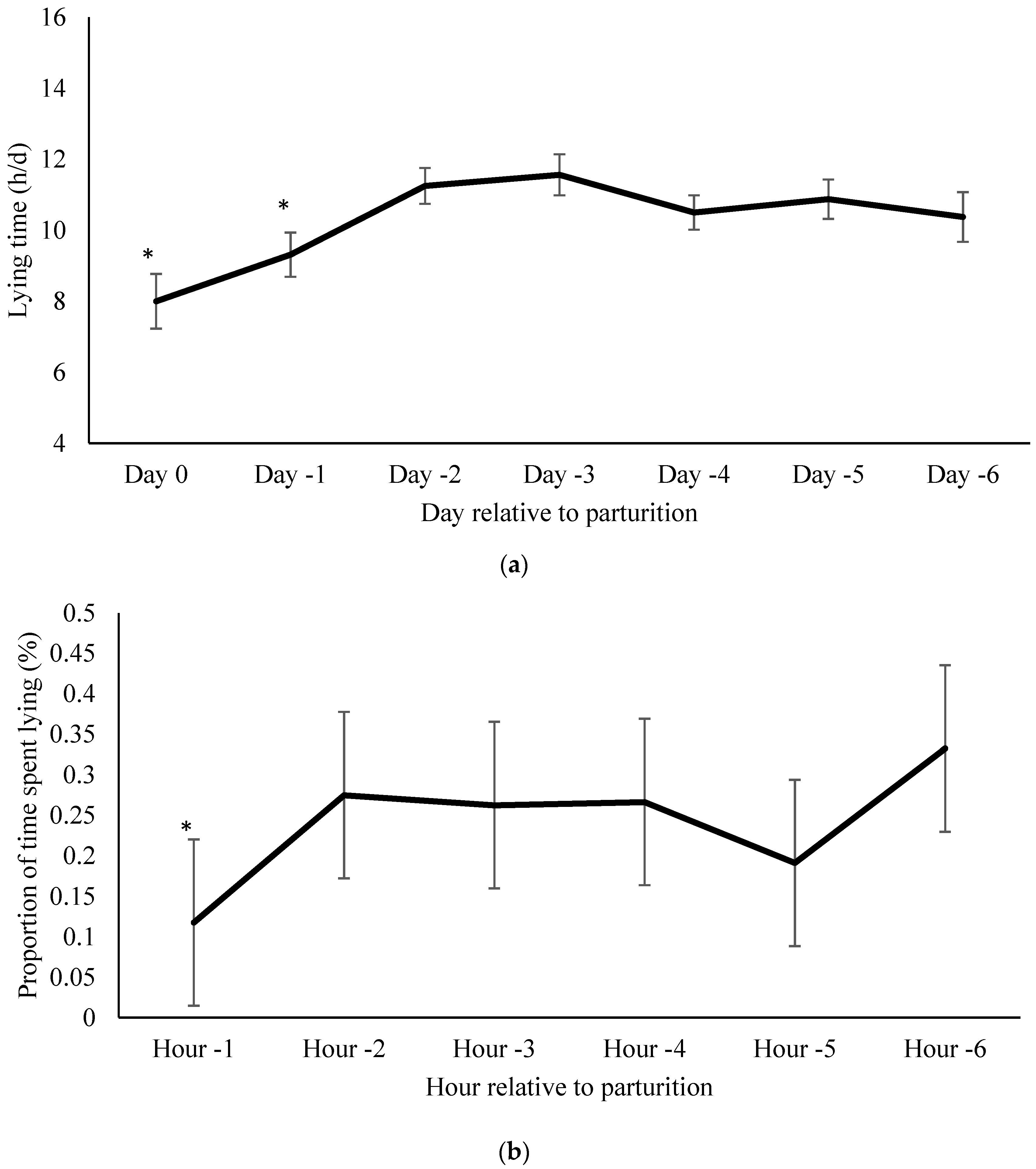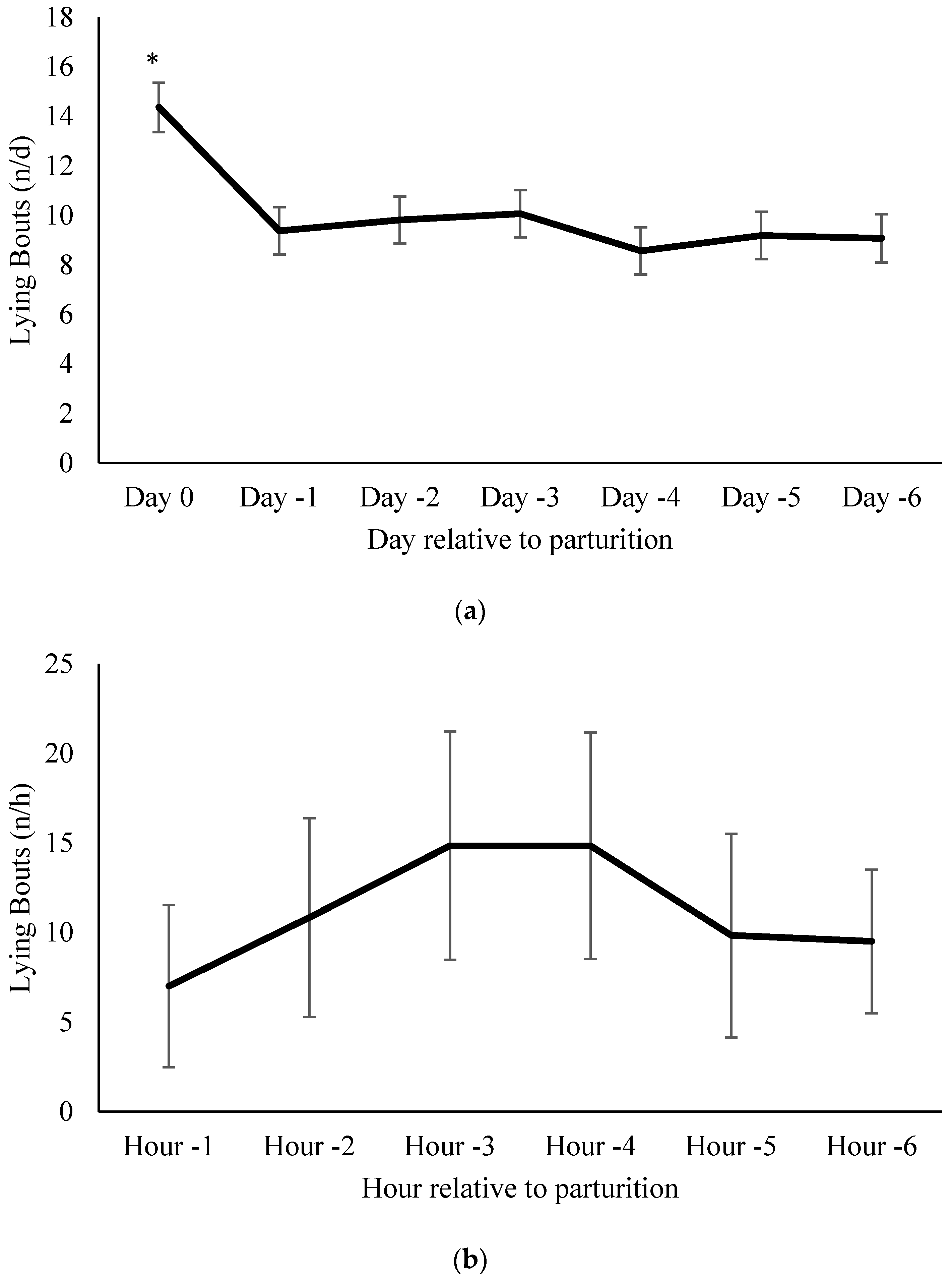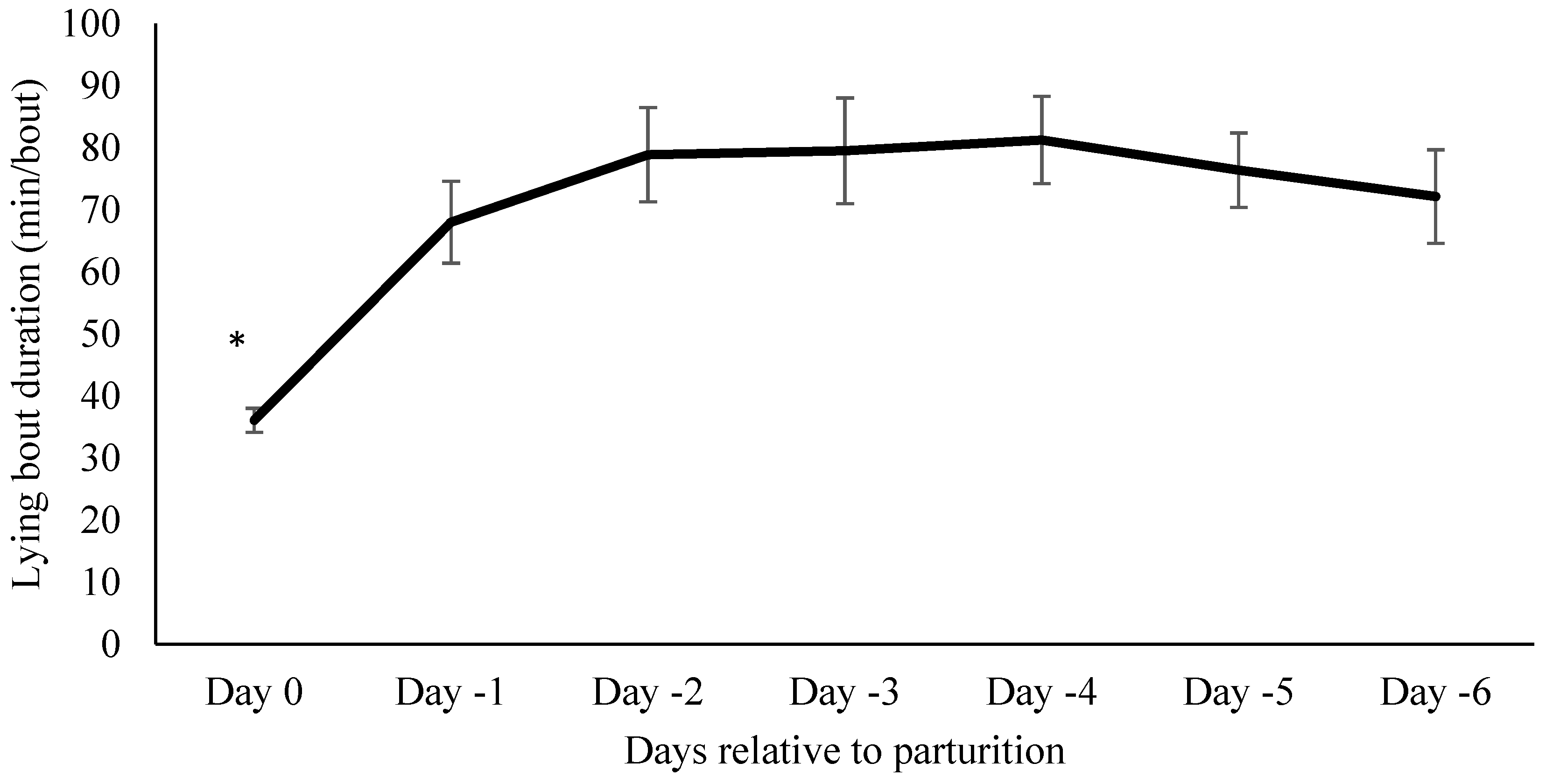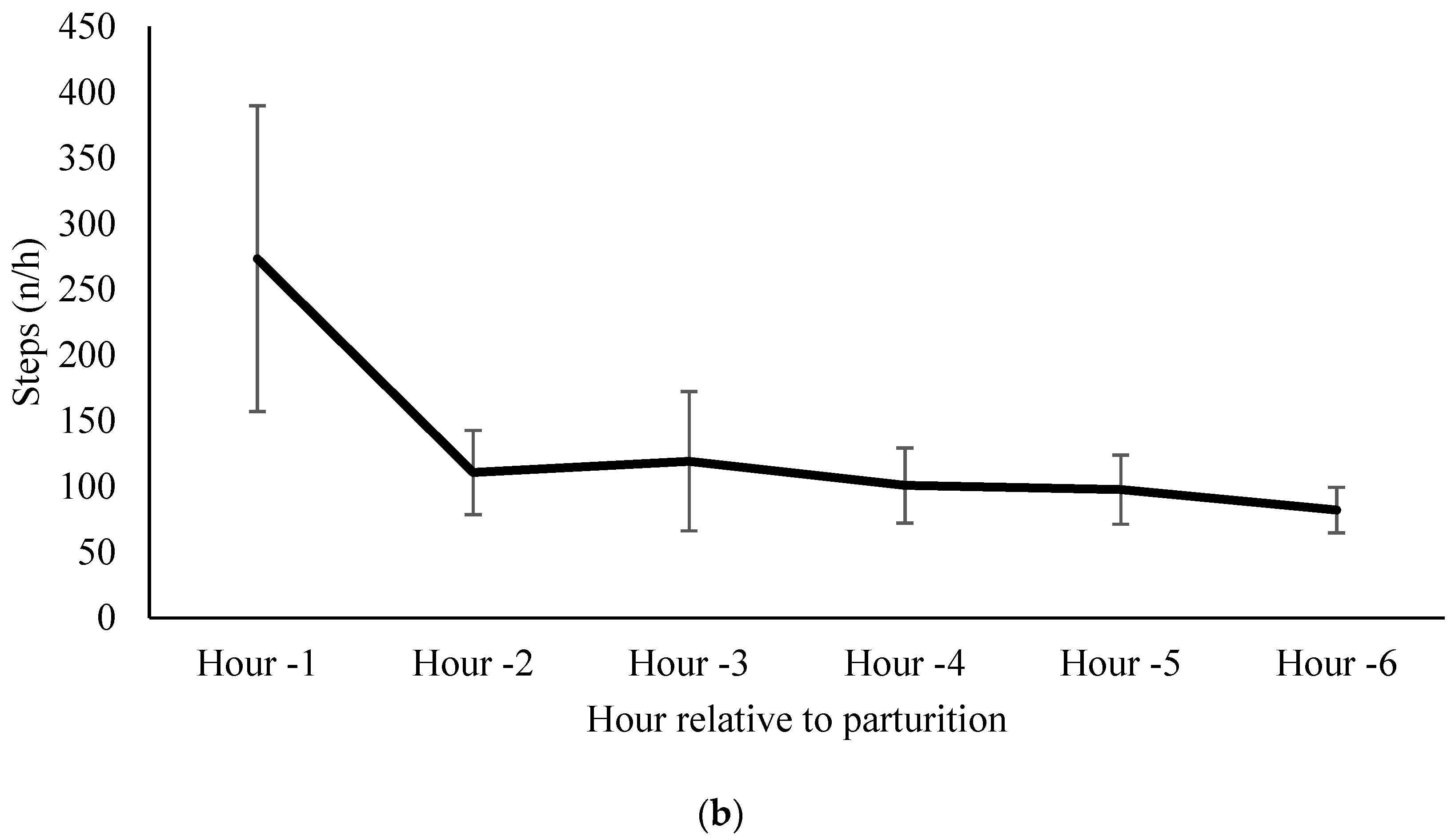Prepartum Lying Behavior of Holstein Dairy Cows Housed on Pasture through Parturition
Abstract
:Simple Summary
Abstract
1. Introduction
2. Materials and Methods
2.1. Animals, Housing, and Measurement
2.2. Data Collection
2.3. Data Analysis
3. Results
3.1. Lying Time
3.2. Number of Lying Bouts
3.3. Lying Bout Duration
3.4. Steps
4. Discussion
4.1. Lying Time
4.2. Number of Lying Bouts
4.3. Lying Bout Duration
4.4. Steps
5. Conclusions
Acknowledgments
Author Contributions
Conflicts of Interest
References
- USDA. Dairy 2014, “Dairy Cattle Management Practices in the United States, 2014”; #692.0216; USDA–APHIS–VS–CEAH–NAHMS: Riverdale, MD, USA, 2016.
- Huzzey, J.M.; von Keyserlingk, M.A.G.; Weary, D.M. Changes in feeding, drinking, and standing behavior of dairy cows during the transition period. J. Dairy Sci. 2005, 88, 2454–2461. [Google Scholar] [CrossRef]
- Jensen, M.B. Behaviour around the time of calving in dairy cows. Appl. Anim. Behav. Sci. 2012, 139, 195–202. [Google Scholar] [CrossRef]
- Proudfoot, K.L.; Veira, D.M.; Weary, D.M.; von Keyserlingk, M.A.G. Competition at the feed bunk changes the feeding, standing, and social behavior of transition dairy cows. J. Dairy Sci. 2009, 92, 3116–3123. [Google Scholar] [CrossRef] [PubMed]
- Miedema, H.M.; Cockram, M.S.; Dwyer, C.M.; Macrae, A.I. Behavioural predictors of the start of normal and dystocic calving in dairy cows and heifers. Appl. Anim. Behav. Sci. 2011, 132, 14–19. [Google Scholar] [CrossRef]
- Hernandez-Mendo, O.; von Keyserlingk, M.A.G.; Veira, D.M.; Weary, D.M. Effects of pasture on lameness in dairy cows. J. Dairy Sci. 2007, 90, 1209–1214. [Google Scholar] [CrossRef]
- Krohn, C.C.; Munksgaard, L. Behavior of dairy-cows kept in extensive (loose housing pasture) or intensive (tie stall) environments 2. Lying and lying-down behavior. Appl. Anim. Behav. Sci. 1993, 37, 1–16. [Google Scholar] [CrossRef]
- Ito, K.; Weary, D.M.; von Keyserlingk, M.A.G. Lying behavior: Assessing within- and between-herd variation in free-stall-housed dairy cows. J. Dairy Sci. 2009, 92, 4412–4420. [Google Scholar] [CrossRef] [PubMed]
- O'Driscoll, K.; Lewis, E.; Kennedy, E. Effect of feed allowance at pasture on lying behaviour and locomotory ability of dairy cows. Appl. Anim. Behav. Sci. 2015, 166, 25–34. [Google Scholar] [CrossRef]
- Tucker, C.B.; Weary, D.M.; Fraser, D. Effects of three types of free-stall surfaces on preferences and stall usage by dairy cows. J. Dairy Sci. 2003, 86, 521–529. [Google Scholar] [CrossRef]
- Tucker, C.B.; Weary, D.M. Bedding on geotextile mattresses: How much is needed to improve cow comfort? J. Dairy Sci. 2004, 87, 2889–2895. [Google Scholar] [CrossRef]
- Tucker, C.B.; Weary, D.M.; Fraser, D. Influence of neck-rail placement on free-stall preference, use, and cleanliness. J. Dairy Sci. 2005, 88, 2730–2737. [Google Scholar] [CrossRef]
- Tucker, C.B.; Cox, N.R.; Weary, D.M.; Spinka, M. Laterality of lying behaviour in dairy cattle. Appl. Anim. Behav. Sci. 2009, 120, 125–131. [Google Scholar] [CrossRef]
- Legrand, A.L.; von Keyserlingk, M.A.G.; Weary, D.M. Preference and usage of pasture versus free-stall housing by lactating dairy cattle. J. Dairy Sci. 2009, 92, 3651–3658. [Google Scholar] [CrossRef] [PubMed]
- Grummer, R.R. Impact of changes in organic nutrient metabolism on feeding the transition dairy-cow. J. Anim. Sci. 1995, 73, 2820–2833. [Google Scholar] [CrossRef] [PubMed]
- Munksgaard, L.; Reenen, C.G.; Boyce, R. Automatic monitoring of lying, standing and walking behavior in dairy cattle. J. Anim. Sci. 2006, 84, 304. [Google Scholar]
- Bewley, J.M.; Boyce, R.E.; Hockin, J.; Munksgaard, L.; Eicher, S.D.; Einstein, M.E.; Schutz, M.M. Influence of milk yield, stage of lactation, and body condition on dairy cattle lying behaviour measured using an automated activity monitoring sensor. J. Dairy Res. 2010, 77, 1–6. [Google Scholar] [CrossRef] [PubMed]
- Siivonen, J.; Taponen, S.; Hovinen, M.; Pastell, M.; Lensink, B.J.; Pyorala, S.; Hanninen, L. Impact of acute clinical mastitis on cow behaviour. Appl. Anim. Behav. Sci. 2011, 132, 101–106. [Google Scholar] [CrossRef]





© 2017 by the authors. Licensee MDPI, Basel, Switzerland. This article is an open access article distributed under the terms and conditions of the Creative Commons Attribution (CC BY) license (http://creativecommons.org/licenses/by/4.0/).
Share and Cite
Rice, C.A.; Eberhart, N.L.; Krawczel, P.D. Prepartum Lying Behavior of Holstein Dairy Cows Housed on Pasture through Parturition. Animals 2017, 7, 32. https://doi.org/10.3390/ani7040032
Rice CA, Eberhart NL, Krawczel PD. Prepartum Lying Behavior of Holstein Dairy Cows Housed on Pasture through Parturition. Animals. 2017; 7(4):32. https://doi.org/10.3390/ani7040032
Chicago/Turabian StyleRice, Christa A., Nicole L. Eberhart, and Peter D. Krawczel. 2017. "Prepartum Lying Behavior of Holstein Dairy Cows Housed on Pasture through Parturition" Animals 7, no. 4: 32. https://doi.org/10.3390/ani7040032





